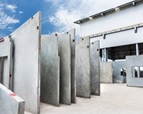You are here: Home » Construction » Concrete Testing » Raw Material Evaluations
Raw Material Evaluations
Concrete is formed by mixing cement with sand, water and aggregate. Cement requires a closely controlled combination of raw materials, including calcium, silicon, iron and aluminium. Common materials used to manufacture cement include limestone, shells, and chalk or marl, combined with shale, clay, slate, blast furnace slag, silica sand, and iron ore. When heated at high temperatures, these materials form a rock-like substance which is ground into the fine powder; this is cement. We can evaluate the quality of the raw materials extracted from the quarry or during the manufacturing process.
During each stage of the production process, materials must be checked and analysed to ensure the quality of the finished product. Different mineral materials, "cement additives", can be added in varying proportions to give the cement specific properties, e.g. reduced permeability, greater resistance to sulfates and aggressive environments, improved workability, or higher-quality finishes. The purity of the cement additives needs to be checked to ensure the correct quantities are added.
We typically conduct X-Ray Diffraction (XRD) and X-Ray Fluorescence Spectrometry (XRF), particle size distribution, petrographic analysis, bulk density determination and a full range of QC chemistry techniques. Our scientists can interpret the results to understand the impact of the analysis on the finished products.


